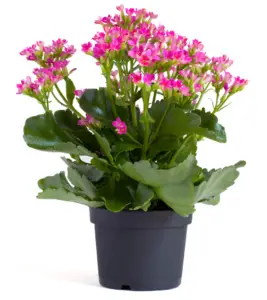
Welcome to my comprehensive guide on growing and caring for Kalanchoe plants. Introduced by Robert Blossfeld, a German hybridizer, in 1932, this plant has become a popular choice as a houseplant due to its ability to enhance the beauty of homes and offices in various settings. Kalanchoe flowers typically have about 26 petals and are complemented by dark green, densely hairy leaves. The blooms showcase a spectrum of colors including red, rose, orange, yellow, and white, making Kalanchoe an ideal choice for beautifying indoor spaces. Between 2013 and 2024, I have nurtured a total of 20 Kalanchoe plants. One of its notable features is its low maintenance requirement; it thrives well with minimal care and naturally flourishes without much intervention.
| Common Name | Kalanchoe, flaming Katy, florists Kalanchoe, Christmas Kalanchoe |
| Botanical Name | Kalanchoe blossfelding |
| Family | Crassulaceae |
| Plant Type | Perennial, succulent |
| Mature Size | 6-18 in. Tall and wide |
| Sun Exposure | Full sun, partial Shade |
| Soil Type | Sandy, Well-drained |
| Soil pH | Acidic, natural, slightly alkaline |
| Bloom Time | Seasonal bloomer |
| Flower Color | Yellow, Red, Orange, Salmon, Pink, White |
| Hardiness Zone | 10-12 (USDA) |
| Native Area | Africa (Madagascar) |
| Toxicity | Toxic to pets |
Kalanchoe Care In-Home
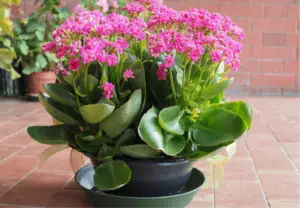
To care for your Kalanchoe plant effectively and ensure it enhances the beauty of your home or office for a long time, there are a few essential things you should know. Drawing from my experience of cultivating this plant from 2013 to 2024, I will share valuable insights. With this knowledge, you can confidently plant and nurture Kalanchoe, knowing that following these guidelines will lead to successful cultivation and maintenance of this plant.
Light

If you’re a regular reader of my blog, you’re probably aware that sunlight is essential for plants as it provides vital nutrients. Therefore, it’s crucial to ensure plants receive adequate sunlight. Different plants have varying sunlight needs—some thrive in direct sunlight, while others require indirect sunlight. The Kalanchoe plant falls into the category that prefers indirect sunlight. Its leaves are sensitive and can easily burn if exposed to direct sunlight, which could lead to the plant’s decline. When placing your Kalanchoe plant indoors, it’s best to position it where it can receive indirect sunlight rather than direct sun exposure. This will help ensure the plant remains healthy and vibrant.
Soil
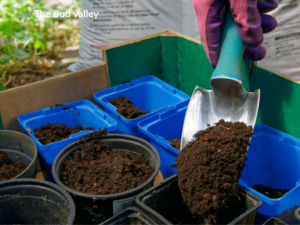
When planting a Kalanchoe in the ground, it relies on the soil for 80% of its nutrients. Therefore, it’s crucial to ensure the soil you choose is nutrient-rich. I prefer using well-draining loam or sandy soil for preparing the planting area. If loam or sandy soil isn’t available, you can create a suitable mix by combining 50% potting soil with 50% cactus mix, or alternatively, 60% potting soil with 40% perlite to improve drainage. This ensures the Kalanchoe plant has the right foundation to thrive and grow healthily.
Water
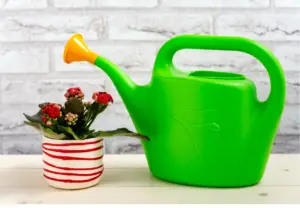
Water is essential for the Kalanchoe plant, but it requires very little. Overwatering can cause root rot, so it’s crucial to water only when the soil at the base of the plant is completely dry. When watering, ensure that the amount of water given is just enough to moisten the soil without allowing it to accumulate at the base of the plant, as good drainage is essential. During winter, when the risk of root rot is higher, reduce the frequency of watering to prevent waterlogged soil conditions.
Temperature

Temperature plays a crucial role for the Kalanchoe plant, as both high and low temperatures can harm it. The ideal temperature range for this plant is between 55°F and 80°F. Within this range, the plant thrives and is less susceptible to damage. It’s important to maintain temperatures within this optimal range to ensure the health and longevity of your Kalanchoe plant.
Fertilizer

Fertilizer plays a crucial role as it provides plants with essential nutrients for growth and flowering. Similarly, Kalanchoe plants benefit from fertilization during the spring and summer months. Apply fertilizer once during this period. It’s important to note that fertilizing should be avoided in winter, a practice I’ve consistently followed to maintain the health of my plants.
Pruning

Pruning is essential for plants as it promotes healthy growth and enhances flower or fruit production. Timing is crucial for effective pruning, as it can significantly benefit the plant’s health and appearance. However, pruning at inappropriate times can harm the plant. For Kalanchoe plants, late winter or early spring is the optimal time for pruning, especially to remove dead flowers and leaves. This practice greatly benefits the plant by ensuring its vigor and overall freshness.
Understanding the Growth Rate of Kalanchoe:

Kalanchoe plants grow faster than many other indoor and outdoor garden plants. Therefore, with good care, your Kalanchoe plant will grow to its full size quite fast.. Here are some tips to help boost the growth rate of your Kalanchoe: Maintain a suitable temperature using a thermostat; plant it in well-drained soil to prevent root rot; ensure it receives adequate sunlight, which is beneficial for growth; choose soil that promotes proper drainage, as waterlogged roots can cause the plant to decline.
Exploring Different Types of Kalanchoe:
Kalanchoe plants come in various shapes, sizes, and colors, offering a wide range of varieties suitable for both indoor and outdoor gardens. Among the most well-known kinds are:
1. Kalanchoe bloss Feldiana: This variety of flowers in red, pink, orange, and yellow tones, adds vibrant colors to any garden.
2. Kalanchoe tomentosa: Also known as the Panda Plant, it is recognized for its fuzzy leaves and distinctive brown spots.
3. Kalanchoe daigre Montana: Commonly called Mother of Thousands, this plant is famous for producing small plantlets along the edges of its leaves, making it a unique addition to any collection.
Propagating Kalanchoe: A Step-by-Step Guide:
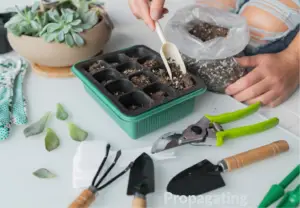
Propagating Kalanchoe plants is a great way to increase your plant collection while enjoying a hobby. Follow these simple steps: start by choosing a healthy stem cutting with at least two leaves; then allow the cutting to air dry to prevent rotting; next, plant the cutting in well-draining soil, and water it carefully; lastly, place it in a warm, well-lit spot and watch it grow!
Potting and Repotting Kalanchoe: Best Practices:
Good potting and repotting practices are essential for the health and growth of your Kalanchoe plants.
1. Use a pot with drainage holes large enough to prevent water accumulation issues.
2. Use a succulent-specific potting mix designed for effective drainage.
3. Repot your plants every two to three years to ensure soil quality and encourage growth.
How to Get Kalanchoe to Bloom:
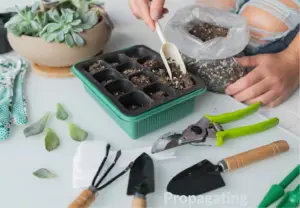
Despite their seemingly simple appearance, one of the reasons people adore kalanchoes is their blooms. To encourage blooming in your kalanchoe, follow these steps:
– Ensure the kalanchoe receives adequate sunlight.
– Avoid moving the plant around excessively to prevent it from going dormant.
– Use balanced fertilizer during the growing season to promote flowering.
Common Problems With Kalanchoe:
While Kalanchoe is a resilient plant, there are several issues to be aware of:
– Overwatering: Leads to root rot and other fungal conditions.
– Pests: Common pests such as aphids and spider mites should be regularly checked for.
– Leggy growth: Weak, elongated stems develop due to insufficient sunlight.
Caring for any type of Kalanchoe plant, whether it’s the Mother of Thousands or Kalanchoe bloss feldiana, can be a rewarding journey for plant lovers. Whether you’re learning about growth rates, exploring different species, mastering propagation, and potting techniques, or understanding common cultivation challenges, these steps ensure the well-being of your Kalanchoe in any environment. Show your plant care and attention, and it will reward you with beautiful flowers and healthy leaves. Best of luck in nurturing your green companions. This blog is brought to you by Bud Valley – your partner in cultivating a thriving green ecosystem. Explore our other articles on indoor flowers, outdoor plants, succulent varieties, and more. Happy gardening!

